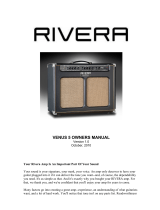Page is loading ...

Service Notes
Tubes
Tubes are consumables, as they have a given usable lifespan. They are part of the
heart of the tone, so keeping correctly operating tubes is essential. Tubes can fail
catastrophically or gradually, and it’s good to know what to look for if they start
to go bad. Periodically inspect them and look to see if anything inside the tube is
glowing cherry red other than the normal orange glow of the filament. This would
indicate a situation where the tube is conducting more current than it is capable
of handling and most likely about to fail. Two other conditions to observe are:
1) filaments not glowing or 2) a miniature fireworks display inside the tube. Any
of the above conditions indicate serious problems with the tube and should be
taken care of immediately. Tubes quite often are the cause of spurious noise in the
amp. Microphonic tubes will squeal or rale with the vibrations of the cabinet.
If suspected, tap each tube lightly with a pencil with the amp powered up—the
suspect tube will let you know. Note that there is a normal metallic clinking when
doing this, but a microphonic tube will be quite loud.
Replacing preamp tubes will not require any adjustment, but the power tubes will
need rebiasing to assure proper operation. After power tube replacement, initially
inspect the tubes often to assure there are no “cherry red” components within
the tube. Tubes today can have a wide variety of tolerances and a re-bias is highly
recommended with new ones.
NOTE! Capacitors may retain an electric charge and can be dangerous even when
the unit is o, unplugged, and has not been played for an extended period of
time. USE CAUTION!!!!
Archon Guitar Amplifier
User’s Manual
© 2014 PRS Guitars - All rights reserved.
“Paul Reed Smith,” “PRS,” the PRS logo, the PRS Paul Reed Smith logo, the Paul Reed Smith signature, the
bird inlays, the headstock bird, the PRS headstock shape, the PRS body shape, the PRS “scoop” design,
“Singlecut”, “Mira” and the “SE” are all registered trademarks of Paul Reed Smith Guitars “Custom
24,” “Modern Eagle,” “SE Custom,” “SC 245,” “SC 250,” “Starla”, “Tonare”, “Sewell”, “ Blue Sierra”, and
“Angelus” are all trademarks of Paul Reed Smith Guitars. The Birds, New Birds, are copyrighted by PRS
Guitars.

Mains Socket: Always use the mains lead supplied. Your sales outlet can provide
a lead suitable for your country. Always disconnect the equipment from the
mains and ancillary units before moving.
Fuses: This amplifier is equipped with multiple accessible fuses. Replacement
fuses must be of the same type and rating as indicated. Failure to comply may
result in permanent damage to the product, and/or create a safety hazard.
Always disconnect the equipment from the mains supply before replacing a fuse.
Mains Fuses: These are located in the mains socket.
Filament Fuses/B+ Fuse: These are located on the top rear of the chassis and are
accessible via thumb-turn fuse holders.
Safety Symbols: The following symbols mean:
Warning: read instructions to understand possible hazard
Danger: electrical shock hazard
Eects Loop: This amplifier features a bypass-able series eects loop that is
integral to the overall sound of the amp. Connect the Send jack with a ¼” mono
instrument cable to the input of your pedal(s). Connect your pedal(s) output to
the Return jack also using a ¼” mono instrument cable.
Output Power: This control allows you to switch o two of the four power
tubes. This causes a volume decrease as well as gives you tonal variation. For
ideal operation, switch the impedance seing to ½ the normal value when using
the 50W seing. For example, when using the 100W seing going into an 8 Ohm
cabinet, use the 8 Ohm impedance seing. When using the 50W seing, switch
the impedance selector to 4 Ohms.
Bias Jacks: These jacks measure the power tube current draw in mV. 1mV = 1mA.
Review the information on the back of this manual for guidance on replacing
tubes. Biasing and tube replacement should be performed only by a qualified
technician.
Speaker Jacks: This is the main output for your speaker cabinet(s). Jacks are
wired in parallel. Only use a high quality speaker cable. Never use an instrument
cable. Please see “Impedance Selector” section below.
Impedance Selector: Use this switch to match the amp to the impedance of
your speaker cabinet(s). The total speaker impedance must be determined
before connecting to the amp. It is not recommended to exceed 2 total speaker
cabinets. Be sure to only use cabinets with the same impedance rating. Failure
to do so can damage the amp. The combined value of 2 matching cabinet
impedances is half of the value of one cabinet’s impedance. Examples: Two 8
ohm cabinets combine to create a 4 ohm combined impedance. If using two 16
ohm cabinets, set the Impedance Selector to 8.
Note: Confirm the total impedance of your choice cabinets and adjust your
Impedance Selector accordingly. Failure to do so can cause arcs on the tube
sockets, failure of power tubes, or even failure of the amp.
Footswitch Jack: Connect the included footswitch to control channel switching
and the eects loop bypass function. When using the footswitch, select the
clean channel on the amplifier front panel for proper function. Only use the
included footswitch. Connection of an improper footswitch may result in
damage to the amplifier.
Rear Panel ControlsUsing your PRS Amplifier
IMPORTANT: Before using your amplifier, refer to the IMPORTANT SAFETY
INSTRUCTIONS insert supplied with the product.
Powering Up:
1. Make sure your speaker cabinet is connected to the correct speaker output
impedance jack with a high quality speaker cable. Do not use guitar cords.
2. Make sure the power cord is connected to the correct grounded outlet.
3. Make sure there is at least 6 inches of clearance behind the amplifier to allow
for proper cooling. Never place the amplifier against a wall or other equipment,
and keep it clear of other heat sources, such as other amplifiers or stoves. Make
sure there are no flammable items, such as curtains, behind the amp. Do not
drape items over the amps that can prevent proper cooling. Do not set drinks or
other liquids on top of the amp that can spill into the amp.
4. To increase the life of the tubes, set the “Standby” switch to the STANDBY
position before powering on. Turn the POWER switch on and let the amplifier
warm up for 2 minutes before seing the standby switch to “ON”. If this is the
first time you are turning on the amp, check to see if all of the tubes are glowing.
5. Plug in the guitar cable, turn the volume knob down, and turn the standby
switch on and wait a few seconds for the bias to sele. Bring the volume up and
play some tunes.
This equipment is capable of very high sound pressure levels. Prolonged exposure
may cause hearing damage.
This equipment contains no user-serviceable parts. Refer all repairs to qualified
service personnel.
Ensure that the mains plug is easily accessible to allow the unit to be switched o.
Only connect this unit to an earthed supply socket.
THIS UNIT IS CLASS 1 CONSTRUCTION AND MUST BE EARTHED!
Input: ¼” Standard Mono Guitar Cable.
Lead/Clean Selector: Select your channels when not using your footswitch. When
footswitch operation is desired, select the clean channel for proper operation.
Channel Controls: Each channel is equipped with a Volume, Treble, Middle, Bass,
and Master control. Use the Volume control to adjust the level of preamp gain.
Use the Master control to adjust the overall channel volume. Adjust the tone
controls to taste.
Bright Switches: These switches allow you to set the overall brightness of each
channel.
Presence/Depth Controls: The Presence and Depth controls are global and aect
both channels. Presence aects the upper high-end, and Depth aects the ultra-
low frequencies.
On/Standby/O: When this switch is in STANDBY, the amplifier tubes are
eectively turned o, but are still being warmed by the filaments. Keep this switch
set to STANDBY when powering on the amplifier for at least 2 minutes to allow the
tubes to warm up. This also helps extend the life of the tubes. When set to ON,
the tubes are turned on and the amplifier can be used.
LED Indicator: Regularly check that when power is applied the mains indicator
lights. If the indicator fails, return the unit for servicing. It must not be used with a
faulty indicator.
Archon Amplifier Front Panel Controls
/





